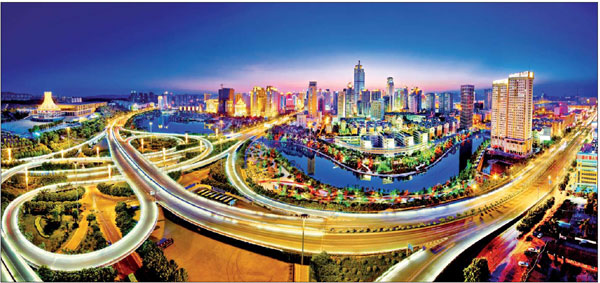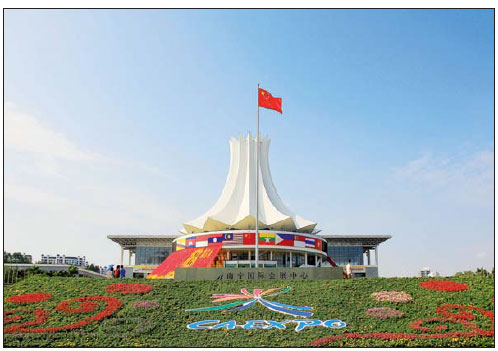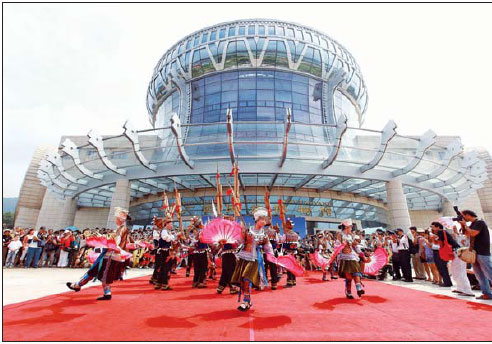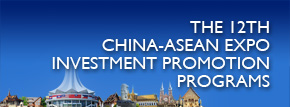Nanning makes efforts to gain lead opening-up role
By : Li Yang And Huo Yan In Nanning, Guangxi(China Daily)
2015-09-18
Nanning, the capital of the Guangxi Zhuang autonomous region, hopes to play a bigger role in China's opening-up to Southeast Asia and the regional development of South China.
Convenient transport
Nanning is about 600 kilometers from Guangzhou, an economic center in South China, and the journey between the two cities in previous years used to take 12 hours by train.
Nanning's city government prioritized transport infrastructure construction to shorten the journey time to important neighbors like Guangzhou in the southeast, Guilin in the north and Qinzhou Port in the south in the Beibu Gulf.
In the past few years, a highspeed railway network has spread across Guangxi with Nanning as its hub. It now takes two hours to reach Guilin and four hours to Guangzhou. The previous 33-hour journey to Beijing and Shanghai has been shortened to about 10 hours.
Nanning has been closely integrated with the economic zones in the Pearl River Delta, Yangtze River Delta and the region around Bohai Bay.
The Nanning-Hanoi passenger train started running in 2009 and the road connecting Nanning with Southeast Asia extends all the way to Singapore. The city's Wuxu International Airport is used by 87 domestic and foreign airlines that run flights to 64 cities, including all capitals of the member states of the Association of Southeast Asian Nations. A new terminal came into use in late September last year, allowing the airport to handle 16 million passengers and 164,000 metric tons of goods a year.
The city is upgrading its port on Xijiang River, which leads to the Pearl River and the South China Sea. By 2020, 2,000-ton ships will be able to reach Guangzhou, Hong Kong and Macao from Nanning via the river, and the annual handling capacity of Nanning Port is expected to hit 22.83 million tons.
Industry and economy
Nanning's gross domestic product was 315 billion yuan ($49.5 billion) last year, up 8.5 percent year-on-year. The city has six key industries: biological medicines, electronic information, machinery equipment, aluminum processing, food and clean energy. The city government plans to develop the city into a regional center for finance, trade, logistics and tourism. The city also aims to promote the development of modern agriculture and agricultural processing industries.
Nanning makes use of the annual China-ASEAN Expo and the China-ASEAN Business and Investment Summit to promote its trade the world. It has been the host city for the events for 12 years. The two events attract more than 600 foreign investors to the city for negotiations and inspections.
Except Laos, all of the other nine ASEAN member states have invested in Nanning. By the end of last year, there were 77 enterprises from the nine countries in the city, investing a total of $1.09 billion in electronics, information, light industry, food, chemical engineering, infrastructure construction, real estate, trade and logistics and agricultural and sideline product deep processing.
From 2004 to 2014, foreign investment in actual use in Nanning accumulated to $3.6 billion, among which $422 million was from ASEAN countries. Six ASEAN countries have set up consulate generals in Nanning and all ten ASEAN countries have founded business liaison offices in the city.
There are six China-ASEAN staple commodity e-trade markets and several China-ASEAN exchange centers in various fields in Nanning. The China-ASEAN commodity trade center and a regional e-commerce headquarters and collecting-and-distributing center are under construction.
Nanning is part of the border-area financial reform test zone and enjoys a series of favorable policies for financial reform made by the central government. The city has made efforts to boost cross-border renminbi settlements between China and ASEAN.
The banking cooperation between Guangxi and ASEAN extends from international settlements to credits and loans, agent financial services and equity investment. With Nanning as a financial center of Guangxi, by the end of October last year, the accumulated volume of cross-border renminbi settlements in Guangxi exceeded $340 billion, ranking it first out of the eight border provincial regions in west China.
In the first half of this year, Nanning had trade exchanges with 56 countries and regions involved in the Belt and Road Initiative that promotes common development, regional integration and industrial cooperation. Trade volume between Nanning and these trade partners was $428 million, of which $361 million was from ASEAN partners.
Regional development
Nanning is in the overlapping area of several economic zones and the country's economic development strategies, which it plays on as its main advantage. The city coordinates with city governments in Guangdong province to deepen its integration with the Pan-Pearl River Delta region and boost intercity cooperation in industrial relocation, infrastructure construction, environmental construction, environmental protection and the financial industry, under the Pearl River-Xijiang River Economic Belt development strategy.
Nanning is about 104 kilometers from Qinzhou, 173 km away from Fangchenggang and 204 km from Beihai, the three deep-water ports to the south that face the Beibu Gulf of the South China Sea. The city is about 200 km from Dongxing and Pingxiang, two land crossings to Vietnam. The Xijiang River flows from Guizhou and Yunnan to the Pearl River and connects Nanning with four Guangxi cities downstream and several important cities in Guangdong, Hong Kong and Macao.
The land, river, air and sea transport options ensures Nanning's position as a logistics hub and regional trade center in South China, and for the nation's opening-up and integration efforts with Southeast Asia.
Former premier Wen Jiabao ordered Nanning to become an inland opening-up economic area in 2010. Current Premier Li Keqiang urged Guangxi to become a strategic pivot for the Southwest and central South China's opening-up in 2013.
Nanning is also a national biological high-tech industrial base, an important base for processing and trade industries transferred from east China and a regional logistics center.
Inhabitable city
Thanks to its humid and warm climate, Nanning, which is also known as a "green city", is famous for its lush greenery, comfortable weather and clean air. The government of Nanning has listed ecological protection as one of its three work priorities along with economy and society.
"Good ecology and comfortable life should be Nanning's brand," said local officials.
Since it was earmarked as the permanent host of the annual China-ASEAN Expo in 2004, the city has invested huge amounts of money to upgrade its city and transport infrastructure, renovating old communities, enlarging public parks and protecting the environment.
The city won the United Nations Habitat Scroll of Honor Award in 2007, as well as several other national-level awards and titles. The city government regards a good living environment as an important factor to attract, not only tourists, but also the professionals from around the world to live and work in the city.
Since 2012, the number of domestic tourists visiting Nanning has increased by an average of 16.43 percent every year, and 22.13 percent for foreign tourists. The city's tourism revenue has risen 23.95 percent annually on average. In the first half of this year, Nanning welcomed about 40.25 million tourists, up 20.25 percent year-on-year, and tourism revenue was about 36 billion yuan, up 24.68 percent year-on-year.
The Nanning city government said it is committed to providing good public services to local residents and efficient administration and services to entrepreneurs. It has developed the first digital-evaluation system in Guangxi for people to assess civil servants and government departments' performance. Nanning has one of the best investment environments among all cities in Guangxi, thanks to the professionalism, efficiency and transparency of the local government.
Future plans
In the future, the city government hopes the central authority will consider moving some big industrial projects to Nanning, especially in its six key industries, promote the industrial development in the area around Nanning Wuxu International Airport, and give bigger support to the construction of the telecommunication infrastructure, and the Nanning-Singapore Industrial Park.
These projects are of vital importance for Nanning's, and even Guangxi's position in the Belt and Road Initiative, the development of the Pearl River and Xijiang River Economic Belt and China's cooperation and integration with ASEAN.
Su Qiulan and Zhang Li contributed to this story.
liyang@chinadaily.com.cn Huoyan@chinadaily.com.cn
|
The warm climate of Nanning off ers a comfortable life for city residents. Photos Provided To China Daily |
|
Nanning is the host city of the annual China-ASEAN Expo. |
|
Guangxi Museum of Nationalities in Nanning has the largest collection of brass drums in the world |
|
|
(China Daily 09/18/2015 page19)









